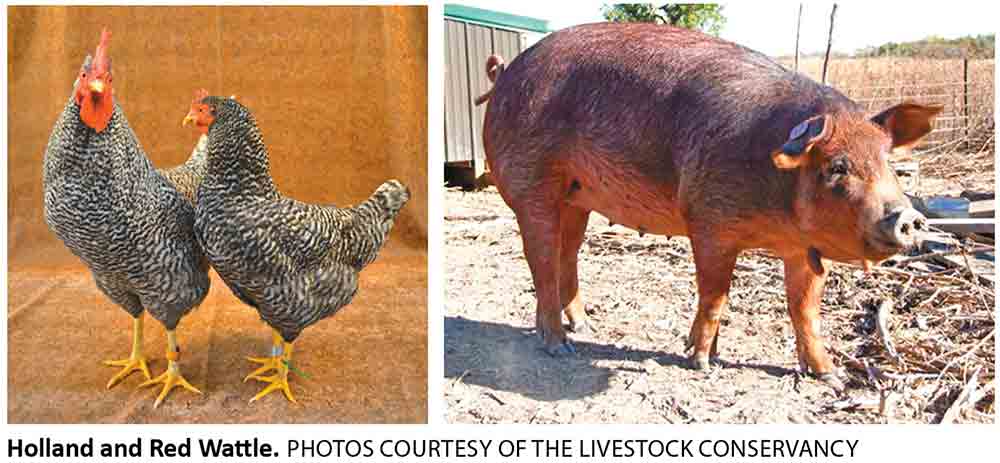
By Matthew R. March, MNRD
Polk County Extension Agent
Heritage breeds are breeds of livestock that were once raised on farms before the modern agricultural period. Many of these heritage breeds became less desirable in the 19th century because they yielded less meat, milk, wool or eggs when raised in the current agricultural systems compared to modern livestock breeds. Though heritage breeds may be lower yielding, they laid the foundation for modern day breeds of livestock through selective breeding of desired traits found in heritage breeds that were selected for modern day livestock breeds.
So why are heritage breeds important? To start, many of these breeds are considered rare or in danger of going extinct. Proponents of heritage breeds argue that it is important to protect these breeds from extinction because heritage breeds retain certain genetics that are important for such traits as fertility, longevity and disease resistance. Though these traits are currently not utilized in current agriculture systems and modern-day livestock, they may be needed in the future as consumer trends, growing systems and climate changes. Such groups as the livestock conservancy and breed associations promote the breeding of these heritage breeds due to unique genetics and traits. According to the livestock conservancy, “heritage breeds store a wealth of genetic resources that are important for our future and the future of our agricultural food system.”
Related Articles
The rest of this article will highlight a handful of heritage breeds from different classes of livestock. The information about these breeds was obtained from the livestock conservancy website. Florida Cracker is one of the oldest breeds of cattle in the United States and was descended from Spanish cattle in the early 1500s. These cattle thrive in the hot humid swamps found in the deep south. Florida Cracker are considered threatened. Milking Devon cattle status is considered critical as only 500 are in existence, mostly at historic farm sites and as exhibition animals. Devon cattle originated in England for meat, dairy and draft. Pilgrims first brought Devon cattle to America, but by the mid-20th century the breeders focused on specializing just in meat production, producing the modern-day Devon or beef Devon. Only a handful of breeders continued to focus on Devon cattle for both milk and meat.
American Cream is the only breed of draft horse developed in the U.S. American Cream can trace their origin to Story County, Iowa in 1911 and have always been considered a rare breed. The horse is considered critically rare, but its numbers have been increasing. Red wattle hog is appropriately named for wattles that are attached to each side of the neck. The wattles have no known function and the breed is unique to North America. Red wattle color can vary from red to light blond to almost black, but the color is consistent throughout the animal. Red wattle can adapt to a variety of climates and are active foragers making them a good selection for pasture swine production. Red wattle status is threatened. Dorset horn sheep are an ancient breed that are known from the hillside pastures of England. The breed can now be found worldwide and is known for extended breeding season and not a seasonal breeding season like most other England sheep. The sheep status is threatened.
A plethora of chicken breeds were developed in the U.S. with a common theme being large frame birds that still produced a fair number of eggs. Farms needed a dual-purpose bird that would both produce eggs consistently and be able to put in a pot if needed. These breeds declined in numbers as the poultry industry specialized in birds that either produced eggs or meat. For this reason, many of the dual-purpose breeds developed in the U.S. are considered heritage breeds. Holland status are critical and were developed in the early 1900s as the first dual purpose breed to lay white eggs. The bird looks like other brown laying breeds like Barred Plymouth or Dominique. Rhode Island Reds are a very popular brown egg-laying bird for backyard flocks. However, the Rhode Island White never became popular and thus its status is considered threatened. Jersey Giant is a very large frame bird that excels in meat production on small farms. The bird is considered a dual-purpose breed, but its large frame makes it popular for meat production. The bird is still common, but its numbers are decreasing.
Heritage breeds can be fun to raise and there is a niche market for their offspring. Heritage breeds do not work in our modern agriculture systems, but they do have certain traits that make them ideal for certain small farms or backyard operations.
You are a guest
or post as a guest
Be the first to comment.

